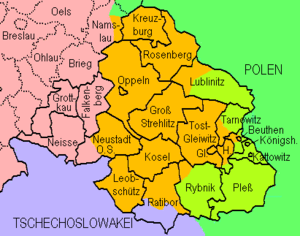| ||||||||||
| Outcome | Upper Silesia is divided. East Upper Silesia goes to Poland. West Upper Silesia goes to Germany. | |||||||||
|---|---|---|---|---|---|---|---|---|---|---|
| Results | ||||||||||
| ||||||||||

Pink = Germany
Green = Poland
Lilac = Czechoslovakia (including, without plebiscite, Hlučín)
Pale green = to Poland following plebiscite
Orange = remaining in Germany following plebiscite
The Upper Silesia plebiscite was a plebiscite mandated by the Versailles Treaty and carried out on 20 March 1921 to determine ownership of the province of Upper Silesia between Weimar Germany and Poland.[1] The region was ethnically mixed with both Germans and Poles; according to prewar statistics, ethnic Poles formed 60 percent of the population.[2] Under the previous rule by the German Empire, Poles claimed they had faced discrimination, making them effectively second class citizens.[3][4][5] The period of the plebiscite campaign and inter-Allied occupation was marked by violence. There were three Polish uprisings, and German volunteer paramilitary units came to the region as well.
The area was policed by French, British, and Italian troops, and overseen by an Inter-Allied Commission. The Allies planned a partition of the region, but a Polish insurgency took control of over half the area. The Germans responded with volunteer paramilitary units from all over Germany, which fought the Polish units. In the end, after renewed Allied military intervention, the final position of the opposing forces became, roughly, the new border. The decision was handed over to the League of Nations, which confirmed this border, and Poland received roughly one third of the plebiscite zone by area, including the greater part of the industrial region.[6]
After the referendum, on 20 October 1921, a conference of ambassadors in Paris decided to divide the region. Consequently, the German-Polish Accord on East Silesia (Geneva Convention), a minority treaty, was concluded on 15 May 1922 which dealt with the constitutional and legal future of Upper Silesia that had partly become Polish territory.
- ^ F. Gregory Campbell, "The Struggle for Upper Silesia, 1919–1922." Journal of Modern History 42.3 (1970): 361–385. online Archived 2022-02-01 at the Wayback Machine
- ^ T. Hunt Tooley, "National Identity and Weimar Germany: Upper Silesia and the eastern border", University of Nebraska Press, 1997, p. 140
- ^ "Racisms Made in Germany" edited by Wulf D. Hund, Wulf Dietmar Hund, Christian Koller, Moshe Zimmermann LIT Verlag Münster 2011 pp. 20, 21
- ^ The Ideology of Kokugo: Nationalizing Language in Modern Japan Lee Yeounsuk p. 161 University of Hawaii Press 2009
- ^ "The Immigrant Threat: The Integration of Old and New Migrants in Western Europe since 1850" (Studies of World Migrations) Leo Lucassen p. 61 University of Illinois Press. 2005
- ^ T. Hunt Tooley, "German political violence and the border plebiscite in Upper Silesia, 1919–1921." Central European History 21.1 (1988): 56–98.